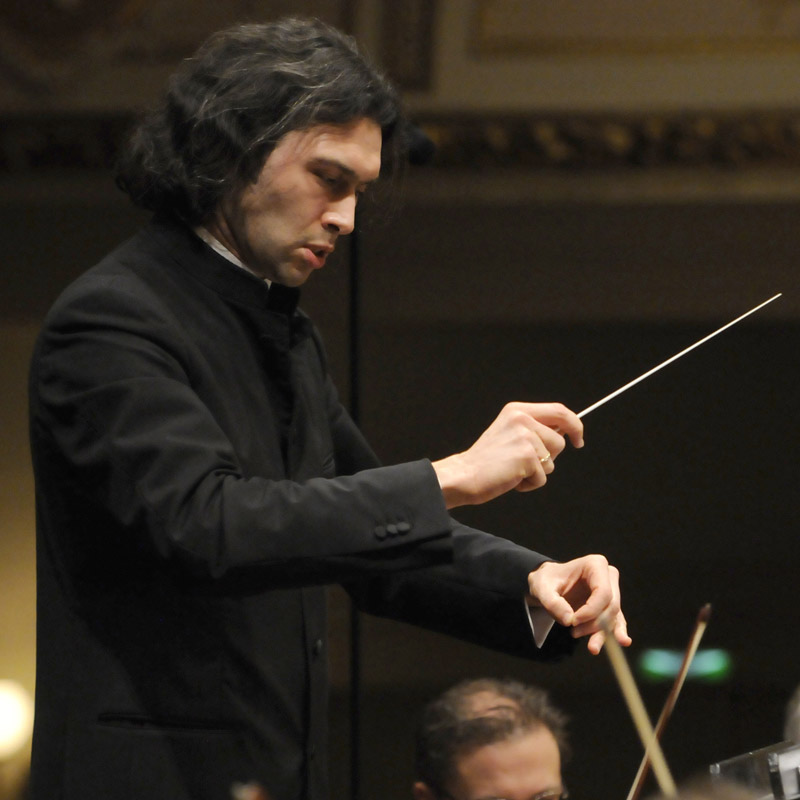Jurowski, BSO put across the sonic fury of Shostakovich’s Fourth with seismic power

Vladimir Jurowski made his Boston Symphony Orchestra debut Thursday night in music of Shostakovich and Mendelssohn.
Musical history is rife with tantalizing conjectural possibilities. What riches would we possess if Mozart or Schubert had been granted a few more years of life? What if all of Bach’s many lost works were rediscovered?
In the 20th century, one of the most intriguing conundrums is what might have happened if the young Dmitri Shostakovich had not run afoul of the Soviet cultural commissars. In 1936 the composer’s “scandalous” opera Lady Macbeth of the Mtensk District was virulently condemned by the powers that be. Shostakovich, alarmed, withdrew the pending premiere of his massive, similarly anarchic Symphony No. 4. Shostakovich never wrote another opera and returned to a more conservative compositional style in his Symphony No. 5, which he penitently inscribed, “A Soviet artist’s reply to just criticism.” The Fourth Symphony was belatedly premiered in 1961 during the Khruschev-era cultural thaw.
Would Shostakovich have continued down the same, more experimental path? Or would he have eventually evolved into a less radical style, regardless of political considerations?
It’s a testament to the extraordinary power and seismic impact of the performance of Shostakovich’s Symphony No. 4 by Vladimir Jurowski and the Boston Symphony Orchestra Thursday night that the historical backdrop, while fascinating, quickly moved into background irrelevancy.
Running over an hour, the symphony is cast in three movements, with two expansive outer sections running 25 minutes each, framing a shorter Moderato. The work is scored for almost comically oversized forces that make Mahler seem inhibited: eight horns, four trumpets, four flutes, four oboes, and massive percussion battery, all of which necessitated a large stage extension jutting out into Symphony Hall to accommodate all the musicians.
It’s not so much that the Fourth Symphony presents a different, unfamiliar Shostakovich but that all of the Russian composer’s characteristic elements—the grinding dissonances, violently contrasted material, perky-sardonic marches and plaintive wind solos—are here amplified and expanded to gargantuan proportions.
Seventy-six years after its completion, this uncompromising music is still jarring and disturbing—the final movement with its opening ironic march and relentless assault of motifs, episodes and fragments leaves one feeling almost pummeled into submission by the dizzying succession of wildly varied, often very loud musical ideas.
Keeping this leviathan on track is an unenviable task and it’s clear that Jurowski scored an unqualified triumph in his BSO debut. The young Russian conductor had the full measure of this sprawling, unkempt yet compelling work and motivated the Boston musicians to playing of a corporate power and intensity that literally had Symphony Hall’s wooden floors trembling.
While Jurowski and the BSO punched across the untrammeled climaxes with tremendous force, it was the conductor’s taut yet flexible control in maintaining structural cohesion and the long view that was consistently impressive. Textures were remarkably transparent for all the massive forces and, individually and collectively, the musicians played for Jurowski with roiling commitment and often startling sonic fury.
For an ensemble fabled for its tonal refinement and polish, it was salient to hear the Boston players’ iron-fingered bravura unleashed, as with the screaming high winds, the unity of the cacophonous assaults by the brass and percussion or the astonishing bravura brilliance of the violins in the lightning-fast fugato section.
I wouldn’t buy the revisionist view of some that the Fourth Symphony is Shostakovich’s true masterpiece, finding it ultimately too discursive and bombastic. But it’s a crucial work in the oeuvre of one of the 20th century’s most important composers and deserves to be heard, particularly when given the full-throttle advocacy of Jurowski and the BSO.
The evening began with reassuring balm before the storm with Mendelssohn’s Violin Concerto.
Arabella Steinbacher returned to Symphony Hall for an uneven performance of Mendelssohn’s evergreen fiddle favorite. The first two movements were dispatched with fluent efficiency by the soloist but felt decidedly chaste in expression, with the lovely Andante cool and unsentimental, some artfully shaded dynamics apart. In the finale, conversely, Steinbacher played with vivacity and spirit, the German violinist sacrificing intonation and clean attacks at times for spontaneity. Still, the work’s sunny lyricism and charm were rarely in evidence. Jurowski and the orchestra provided alert playing and fiery tuttis for their soloist but this was not Mendelssohn to stay long in the memory.
The program will be repeated 1:30 p.m. Friday and 8 p.m. Saturday. bso.org.
Posted in Performances